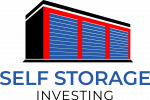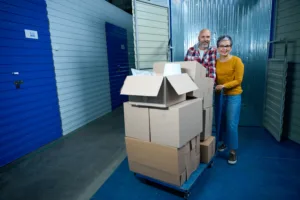In today’s ever-changing world, business is not as usual, and many people have found themselves looking at more profitable investments that can stand the test of recessions and unprecedented world events. One of those stand-out industries is self-storage investments.
Moving around often and downsizing is so common nowadays that self-storage units have become a highly sought-after commodity and are here to stay for the long term. Entrepreneurs and investors have made a large leap toward the self-storage sector and found it a niche worth paying great attention to, with its high profit margin and reliable cash flow.
What is self-storage investing?
Driving through any city, it is hard not to notice simple cube-shaped buildings with names such as CubeSmart, Public Storage, U-Haul, and Extra Space Storage. These buildings house climate-controlled and secured self-storage units that individuals and businesses can rent for a nominal fee. Many of the self-storage properties are owned by large corporations, but there is an increasing number of successful mom-and-pop storage investors that are important players in the real estate investment market.
In recent years, investment in storage units has gained great momentum due to its convenience for small business owners who have been forced to downsize their businesses as a result of the current economic changes in the world. As many stores are going online, shop owners find it convenient to store their inventory in protected storage facilities.
In addition, increasing rent costs have pushed many individuals to downsize and store their belongings elsewhere. For these individuals, storage facilities have become a life-saving long-term solution. Due to the increasing popularity of self-storage facilities, with an average occupancy around 90%, new and seasoned entrepreneurs alike are taking notice and changing the landscape of real estate investing.

What makes investment in storage units so valuable in today’s real estate investing?
Investors are flocking to self-storage real estate due to its unique and lucrative qualities, seeing storage investing as an excellent strategy to make passive income without relying on the volatility of the stock market. While more than 50% of other commercial real estate businesses don’t make a profit, self-storage investments have shown a success rate of 92%. Some sources list the self-storage real estate profit margin as 11% (Forbes), but others lean toward a higher value of 29.6% (Parham Group).
Because these self-storage facilities are often simple buildings with basic infrastructure, the cost of building them is much lower than for buildings intended for residential housing. As storage facilities are often located in neighborhoods and areas with low property costs, building and renting self-storage real estate can be quite profitable. In fact, because the overhead costs are so low and demand for storage units so high, many investors have been able to gain substantial passive cash flow from their self-storage real estate investments.
Since these self-storage units house objects instead of people, building them is less complicated and restricted, making it possible to build storage unit real estate quickly, on a budget, and without much hassle. Once the facilities are built, they are also easier to upkeep thanks to having less chance of wear-and-tear, ensuring that the operation costs stay low.
Some self-storage entrepreneurs also find that not having tenants living on their properties gives them the emotional distance needed for peace of mind and greater assurance that the rent will be paid in full and on time. Because rent contracts are renewable every month, owners can capitalize on ever-increasing storage unit rent prices.
How do I invest in self-storage real estate?
There are active and passive ways of investing in self-storage real estate, and your choice of investment will depend on your needs and reasons for investing. If you want a hands-off investment with little time to think about it, consider purchasing a share in a self-storage real estate investment trust. Storage real estate investment trusts (REITs) are owned and managed by real estate companies that take care of all the investment details for you. Many people invest in storage REITs through their 401(k), but there are also other investment options.
If you want to be a business owner with your own self-storage facility, you can choose from building a new storage facility or buying an existing one. If going through the buying process alone seems too intimidating, you can hire a commercial broker to make your experience smoother and quicker.
If, on the other hand, you decide to buy an existing unit, there are a few important steps to take before jumping into such an investment. Hiring an inspector to evaluate the safety and condition of the existing facility may seem like an extravagant expense upfront, but it will save you time, headaches, and money in the long run.
Once you purchase your self-storage facility, you can manage it alone or hire an operations team, but another option is to employ a management company that can take care of all the operational and administrative tasks for you. This is another great benefit of self-storage investing since it could truly be a hands-off way to gain passive income with constant cash flow.
A very important aspect of setting up your business for operation is to establish it as a legal business entity such as an LLC, with all rights reserved, or a corporation to avoid being personally liable if your business gets sued. Registering for local and federal taxes, securing permits and licenses, and getting appropriate insurance will be other important matters to settle before you can open your storage unit facility for business.

How much does it cost to invest in storage units?
The cost of your self-storage business will depend on the size, location, and nature of your storage facility. Building your own facility involves many costs, including buying land, getting the required permits, inspection, insurance, legal representation, interest, design and construction, furnishings, closing costs, and advertising. Summing up all these expenses, you can expect to pay anywhere between $25 to $40 per square foot for a one-story building or $42 to $70 per square foot for a multi-story building.
Purchasing an existing building may be a much more affordable option, but make sure to inspect the building before your purchase to determine any additional expenses needed for repairs and renovation.
How do I finance my storage unit investments?
Depending on your financial standing, you may be eligible for loans that can help you finance your self-storage investments. One option is to see if you can get a loan through the small business association (SBA), which offers storage unit investors the SBA 504 loan for building a new facility and the SBA 7a loan for buying an already built facility. These loans are a popular option because they have lower down payments and have extra perks such as overhead and capital improvement costs being calculated into the loans beforehand.
There are many possibilities when it comes to the kind of self-storage real estate you could purchase or build. If you are thinking of building a storage facility in a rural location, see if you qualify for a farm storage facility loan. The United States Department of Agriculture offers low-interest loans with many other benefits to investors who are planning to build a self-storage unit in a farm setting.
If you don’t qualify for SBA loans, you can still try conventional commercial real estate loans (CRA), though they have a higher down payment rate without the capital improvement perks of SBA loans. If conventional loans aren’t an option, you can try to find grants, loans from small microfinance organizations, or even crowdfunding.
How do I attract my ideal customers?
Creating a powerful and effective marketing strategy for your business will be the key to your overall success in renting your self-storage units to customers who need them the most. The first question to ask yourself is, what kind of niche will you be catering to? Is it a luxury-minded customer that wants to store expensive heirlooms or someone who needs low-cost storage for extra home furnishings? Will your facility serve as inventory storage space for shops that sell non-perishable items or stores carrying products with expiration dates?
Once you have an idea of which demographic is most likely to rent your storage units, you can then create a brand identity to attract these customers and make it easier for them to find you. Listing your business on Google My Business and other map directories such as MapQuest and Bing Maps will allow your customers to find you through an online search for a local self-storage facility.

How do I price my storage units?
In the United States, renting a 10-by-10-foot self-storage unit averages $107 per month for a unit with the most basic amenities and $126 for a climate-controlled unit. The way you determine rental rates for your units depends on which part of the country it is located in and whether it is in a suburban, urban, or rural setting. You can use online tools on websites such as LifeStorage to find out how much your competition is currently charging for rent. The more perks you include in your service package, the higher your rent can be. If you are targeting well-to-do clientele that will most likely request specialized services, your price can increase accordingly.
One great benefit of investing in storage units is that you can modify rent prices on a month-to-month basis. If your occupancy is very high, you can increase your prices the next month, improving your cash flow quickly. If there are some off-season months, you can lower your rent accordingly so that you can attract more customers.
What are future projections for the self-storage industry?
Over the past few years, the self-storage industry has boomed due to the high demand, ease of investment, and high profitability of this kind of business. Many people have jumped on the wagon of self-storage investing, and in, the next few years, the industry is projected to grow exponentially. The danger is that the industry will grow so large that the demand for storage units will decline, and rental prices for the units could go down substantially.
The key to being competitive in this market in the future is to have an innovative twist to your self-storage business. You can even look into providing storage units for a specific niche of people. For example, you can create a self-storage business that caters to art collectors where you specifically build your units with climate control to protect and preserve the art which will be stored there. Securing yourself in this niche may also mean that you can charge higher rent since your target audience is a part of the luxury market.
If you are able to add more services to your existing repertoire of offerings, you are more likely to secure additional income. From the above example of a business geared toward art collectors, you can also offer pickups and deliveries of the artwork, as well as packaging the art for transport and installing it once it is delivered to the desired location.
Another idea is to make your storage building convertible to another kind of business. This may mean that you have to choose a more suitable location for your initial investment and to adhere to stricter building codes from the beginning, but it could, in the long run, be worth it to protect you from business and income stream loss.
Takeaway
There will always be a need for storage spaces, making this investment option much less volatile and risky in the long run than other investment types.
Now, you’re almost ready to invest the right way to generate consistent passive income. For a limited time, you can access our Investor Portal with courses and resources that will give you our tips and tricks to become a successful investor.





